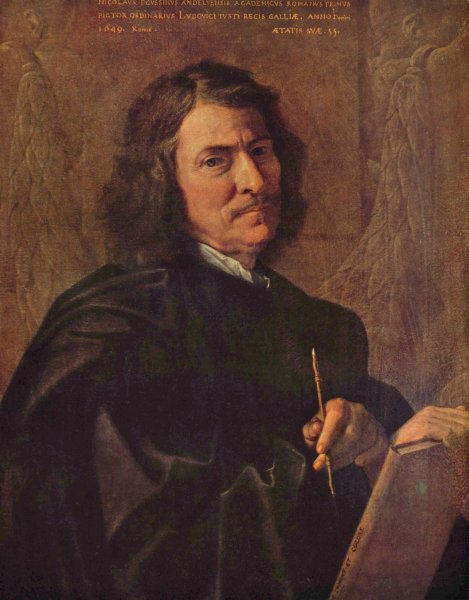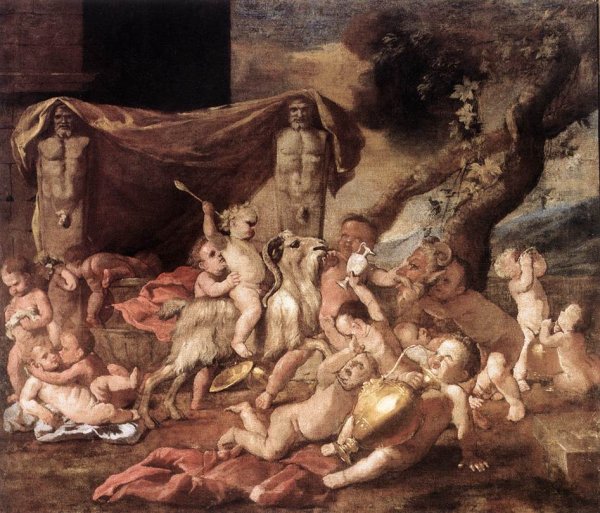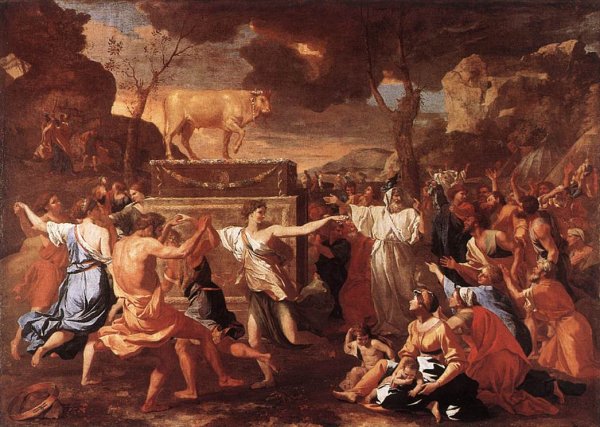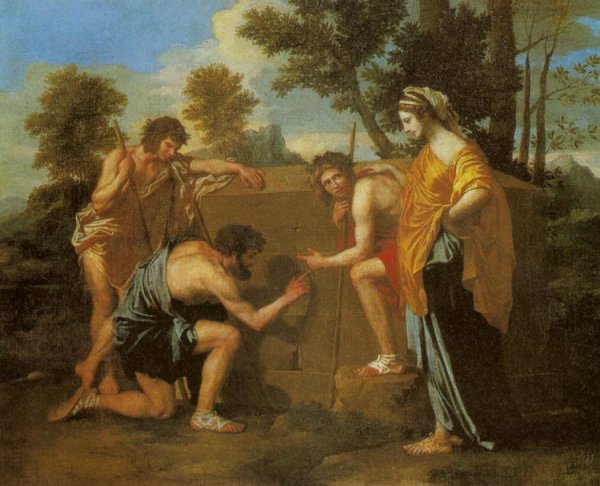Nicolas Poussin Biography In Details
Early career

Nicolas Poussin's early biographer was his friend Giovanni Pietro Bellori, who relates that Poussin was born near Les Andelys in Normandy and that he received an education that included some Latin, which would stand him in good stead. Early sketches attracted the notice of Quentin Varin, a local painter, whose pupil Poussin became, until he ran away to Paris at the age of eighteen. There he entered the studios of the Flemish painter Ferdinand Elle and then of Georges Lallemand, both minor masters now remembered for having tutored Poussin. He found French art in a stage of transition: the old apprenticeship system was disturbed, and the academic training destined to supplant it was not yet established by Simon Vouet; but having met Courtois the mathematician, Poussin was fired by the study of his collection of engravings by Marcantonio Raimondi after Italian masters.
After two abortive attempts to reach Rome, he fell in with Giambattista Marino, the court poet to Marie de Medici, at Lyon. Marino employed him on illustrations to his poem Adone (untraced) and on a series of illustrations for a projected edition of Ovid's Metamorphoses, took him into his household, and in 1624 enabled Poussin (who had been detained by commissions in Lyon and Paris) to rejoin him at Rome.
Early years in Rome

In Rome, his patron having died, Poussin, who lodged at first with Simon Vouet, fell into great distress, with the departure for Spain of his early patron Cardinal Francesco Barberini and the Cardinal's secretary, the antiquary Cassiano dal Pozzo, later a great friend and patron. The return of Barberini from Spain in 1626 stabilized and renewed the patronage of the Barberini and their circle. Two major commissions at this period resulted in Poussin's early masterwork the Barberini Death of Germanicus, partly inspired by the reliefs of the Meleager sarcophagus, and the commission for St. Peter's that amounted to a public debut, the Martyrdom of St. Erasmus (1630), with echoes of Pietro da Cortona. Falling ill at this time, he was received into the house of his compatriot Gaspard Dughet and nursed by his daughter Anna Maria to whom, in 1630, Poussin was married.
He lodged with the sculptor Francois Duquesnoy, of an equally classicizing artistic temperament, befriended Domenichino and joined an informal academy of artists and patrons opposed to the current Baroque style that formed around Joachim von Sandrart.
Among his first patrons, aside from Cardinal Francesco were: Cardinal Omodei, for whom he produced, in 1627, the Triumphs of Flora (Louvre); Cardinal de Richelieu, who commissioned a Bacchanal (Louvre); Vincenzo Giustiniani, for whom was executed the Massacre of the Innocents, of which there is a first sketch in the British Museum; Cassiano dal Pozzo, who became the owner of the first series of the Seven Sacraments (Belvoir Castle); and Paul Freart de Chantelou, with whom in 1640 Poussin, at the call of Sublet de Noyers, returned to France.
Poussin in France

Louis XIII conferred on him the title of First Painter in Ordinary. In two years at Paris he produced several pictures for the royal chapels (the Last Supper, painted for Versailles, now in the Louvre), eight cartoons for the Gobelins tapestry manufactory, the series of the Labors of Hercules for the Louvre, the Triumph of Truth for Cardinal Richelieu (Louvre), and much minor work.
In 1643, disgusted by the intrigues of Simon Vouet, Fouquieres and the architect Jacques Lemercier, Poussin withdrew to Rome. There, in 1648, he finished for de Chantelou the second series of the Seven Sacraments (Bridgewater Gallery), and also his noble Landscape with Diogenes (Louvre). This painting shows the philosopher discarding his last worldly possession, his cup, after watching a man drink water by cupping his hands. In 1649 he painted the Vision of St Paul (Louvre) for the comic poet Paul Scarron, and in 1651 the Holy Family (Louvre) for the duc de Crequy. Year by year he continued to produce an enormous variety of works, many of which are included in the list given by Felibien.
He suffered from declining health after 1650, and was troubled by a worsening tremor in his hand, evidence of which is apparent in his late drawings. He died in Rome on November 19, 1665 and was buried in the church of San Lorenzo in Lucina, his wife having predeceased him. Chateaubriand in 1820 donated the monument to Poussin.
Poussin left no children, but he adopted as his son Gaspard Dughet (Gasparo Duche), his wife's brother, who became a painter and took the name of Poussin.
Works

The finest collection of Poussin's paintings, in addition to his drawings, is located in the Louvre in Paris. Besides the pictures in the National Gallery and at Dulwich, England possesses several of his most considerable works: The Triumph of Pan is at Basildon House, near to Pangbourne, (Berkshire), and his great allegorical painting of the Arts at Knowsley. The later version of Tancred and Erminia is at the Barber Institute in Birmingham. At Rome, in the Colonna and Valentini Palaces, are notable works by him, and one of the private apartments of Prince Doria is decorated by a great series of landscapes in distemper.
Throughout his life he stood aloof from the popular movement of his native school. French art in his day was purely decorative, but in Poussin we find a survival of the impulses of the Renaissance coupled with conscious reference to classic work as the standard of excellence. In general we see his paintings at a great disadvantage: for the color, even of the best preserved, has changed in parts, so that the harmony is disturbed; and the noble construction of his designs can be better seen in engravings than in the original. Among the many who have reproduced his works, Audran, Claudine Stella, Picart and Pesne are the most successful.
Legacy

Initially, Poussin's genius was recognized only by small circles of collectors. (In the two decades following his death, a particularly large collection of his works was amassed by Louis XIV.) At the same time, it was recognized that he had contributed a new theme of "classical severity" to French art.
Benjamin West, an American painter of the 18th century who worked in Britain, based his canvas of the death of General Wolfe at Quebec on Poussin's example. As a result, the image is one in which each character gazes with appropriate seriousness on Wolfe's death after securing British domination of North America.
Jacques-Louis David resurrected a style already known as "Poussinesque" during the French Revolution in part because the leaders of the Revolution looked to replace the frivolity and oppression of the court with Republican severity and civic-mindedness, most obvious in David's dramatic canvas of Brutus receiving the bodies of his sons, sacrificed to his own principles, and the famous death of Marat.
Throughout the 19th century, Poussin, available to the ordinary person's gaze because the Revolution had opened the collections of the Louvre, was inspirational for thoughtful and self-reflexive artists who pondered their own work methods, notably Cezanne, who strove to "recreate Poussin after nature", and the Post-Impressionists. The less thoughtful enjoyed the eroticism of some of Poussin's classicizing subjects (illustration, left).
In the twentieth century art critics have suggested that the "analytic Cubist" experiments of Pablo Picasso and Georges Braque were founded upon Poussin's example.
The most famous 20th-century scholar of Poussin was the Englishman Anthony Blunt, Keeper of the Queen's Pictures, who in 1979 was disgraced by revelations of his complicity with Soviet intelligence.
Today, Poussin's paintings at the Louvre reside in a gallery dedicated to him. (From Wikipedia)




